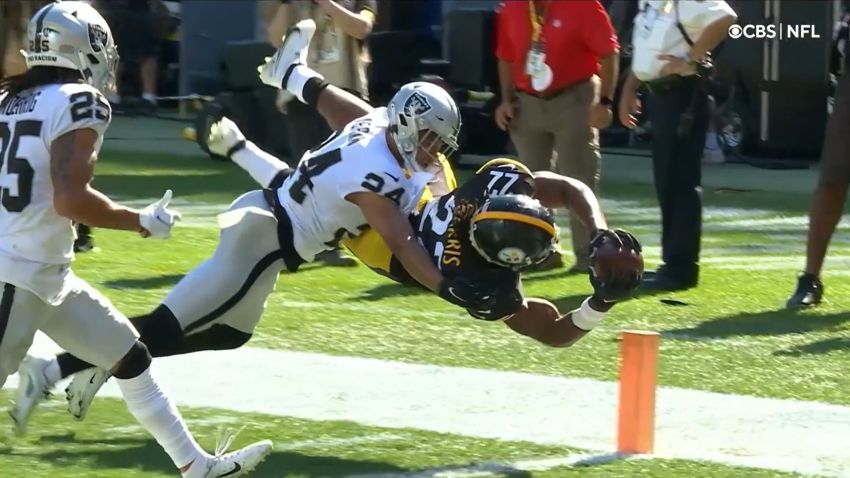Last season, I conducted a study on rookie RB Najee Harris and tried to project what impact he would have from a fantasy football perspective in his first season with the Pittsburgh Steelers. Being his first season in the NFL as a first round pick out of Alabama, Harris had no previous exposure to the NFL game, making projecting his 2021 stat line more of comparison of what he accomplished in college along with historical trends for the starting RB of the Pittsburgh Steelers. After conducting the study I provided the following statement:
Personally, I would expect Harris to be closer to 18-20 carries a game if game script permits it, and possibly see just a few less receptions total over the course of his rookie season. Say Harris averages 17 carries a game at the same YPC as above, and instead catches a safer estimate of 55 passes on the season. His totals would come out to 1,213 rushing yards and 495 receiving yards, 1,708 total yards from scrimmage. Having a nose for the end zone and being a viable receiving threat, it’s not out of the question for Harris to score 10 touchdowns on the ground and two through the air, thus equating to 12 total scores.
So, when transferring that over to fantasy points, that would come out to 242.8 non-PPR or 297.8 full-PPR fantasy points based on the information provided by Fantasy Data. For context, that would have placed Najee Harris as RB #4 in non-PPR and RB #8 in full-PPR in 2020 in ESPN fantasy football leagues, understanding that Harris will have played an extra game.
I projected Harris to have 289 carries for 1,213 rushing yards, 55 receptions for 495 yards, and 12 total touchdowns (ten rushing, two receiving) and 297.8 full-PPR fantasy points, being the RB in full-PPR leagues based on 2020’s rankings. Najee’s actual state line? 307 carries for 1,200 yards, 74 receptions for 467 yards, ten total TDs (seven rushing, three receiving), and 300.7 full-PPR fantasy points, finishing as the RB4 in total points and RB8 in point-per-game.
Ok, I’m done patting myself on the back, but outside of the increased carries and receptions, the yardage Harris accumulated in 2021 was nearly identical to my projections. Obviously, we would have liked to see Harris be more efficient than he was last season on his touches as volume willed him to a top five finish.
This raises the question: what can we expect from Harris in Year Two in Pittsburgh? Frankly, more of the same thing in terms of being a workhorse RB who will see the ball a ton both on the ground as well as in the air. As much as Pittsburgh wants to say that they want to lessen his number of snaps on the field and that they want Harris to get more of a breather with other backs getting in the mix this season, the fact is Harris is by-far Pittsburgh’s best player at the position and isn’t someone they can pull off the field for long periods of time without experiencing a drop off in play.
Mike Tomlin said as much during his appearance on The Pivot Podcast, calling Harris a workhorse back that the offense will lean on this season with Ben Roethlisberger retiring. So what might that “workhorse role” look like for Harris in 2022? From 2013 to 2018, Pittsburgh’s lead tailback has averaged 255 carries (counting missed time by Bell, DeAngelo Williams, and James Conner due to injuries) for the season along with 63 receptions on the year, coming out to 318 total touches. Harris blew past both of those marks in 2021, toting the rock 307 times on the ground along with catching 74 passes.
With the retirement of Roethlisberger and having either Mitch Trubisky or Kenny Pickett projected to start at QB in 2022, the expectation is that Pittsburgh will become a more balanced offense after ranking top five in pass attempts in each of Ben’s last three healthy seasons. Still, while Pittsburgh had 664 pass attempts in 2021, the leave average was 584 attempts, and with Pittsburgh more likely to be in close games rather than blowing teams out this season, we shouldn’t expect their overall pass attempts to cater.
Pittsburgh logged 411 rush attempts last season where Harris saw 307 of those opportunities (74.7%). While we can expect other backs to get in the mix this season, it wouldn’t be unrealistic for Harris to see close to 75% of the rush attempts this season. 411 rush attempts equated to nearly 37% of Pittsburgh’s total plays last season (1,113). Assuming Pittsburgh remains above league-average in pass attempts, and they run a similar number of plays, Pittsburgh could be around 444 rush attempts. Should Harris get close to 75% of those attempts he would be looking at 333 carries. Say Harris just slightly increases his YPC from 3.9 to just 4.0, that would put him at 1,332 rushing yards.
As far as pass game involvement, should Pittsburgh’s passing plays drop from just over 39-per-game to 35-per-game, that would put the team around 595 attempts. Harris saw a 14% target share last season, reeling in 74 receptions on 94 targets. Say the new QB doesn’t target the running back as much in the passing game as Ben did checking the ball down and Harris’s target share drops to 12%, he would see roughly 74 targets. If we keep his catch percentage the same from last season, that will equate to 55 receptions. However, should his YPR increase just slightly from 6.3 last season to 7.0 this year, that would come out to 389 yards receiving.
So, right now we have Harris with 33 carries for 1,332 rushing yards and 55 receptions for 389 receiving yards, coming out to 1,721 yards of total offense. What about touchdowns? Well, last season Harris posted a 2.2% TD rate on his carries and 4.0% TD rate on his receptions. Should that rushing TD rate rise from 2.2% to 3%, Harris could see ten rushing scores. With his total passing down work dropping compared to last season, two receiving TDs would be a logical estimate for what his TD rate was last season, putting his total TDs to 12, matching like I projected for his 2021 season.
Overall, while seeing Harris’s passing down work drop off compared to last season may not be ideal, seeing just a slight improvement in efficiency as a runner would more than make up for that loss of passing down work. My projections would put Harris close to his yardage total last season and well in the range of that workhorse category. Should Harris match those totals, his total PPR fantasy points could come out to 299, nearly identical to his 2021 finish.
Now, while Harris finished as the PPR RB4 last season, he was RB8 on a per-game basis factoring injuries. However, in a league where injuries occur often, especially at the RB position, it is reasonable to expect several of the top backs will get hurt at some point, meaning that it is important for players to remain healthy the entire season. Given Harris’s youth and ability to carry a heavy workload last season, he has just a good a chance as any to remain healthy and play a full season compared to other backs like Derrick Henry, Christian McCaffrey, and Alvin Kamara who all dealt with injuries last season.
In conclusion, Najee Harris should once again be a first-round pick in fantasy football leagues in 2022 thanks to a guaranteed workhorse role as both a rusher as well as a pass catcher. Should his efficiency improve just slightly, he could be in-line for a great statistical season and a good bet to finish in the top five of his position again this coming season. If you want to mitigate risk with more volatile players with an injury history, Harris is the ideal safe selection to kick off your fantasy draft.
What are your thoughts on Najee Harris and his upcoming 2022 season? Do you think that he could post top five numbers at the RB position like he did in 2021? Do you think that his efficiency will improve compared to last year? Please leave your thoughts in the comments section below and thanks again for reading!








